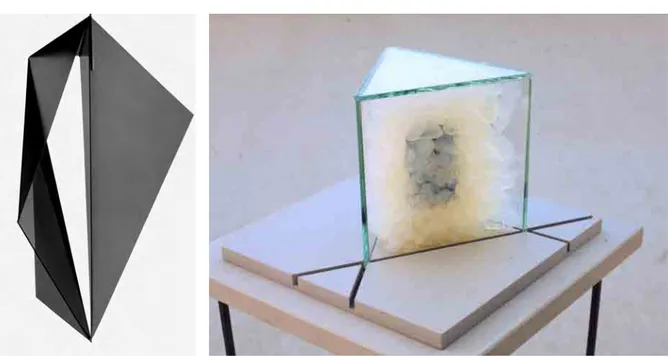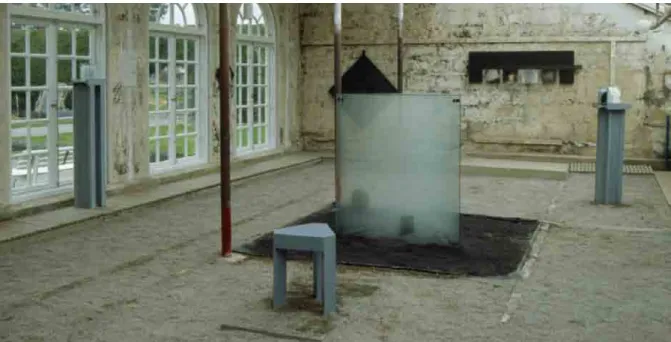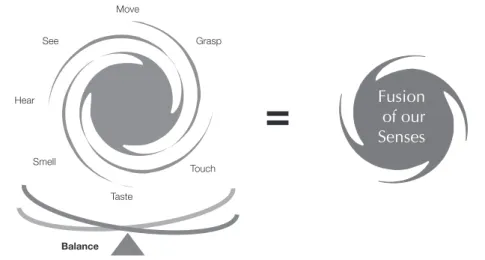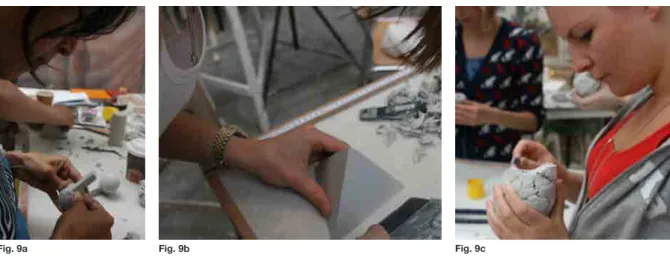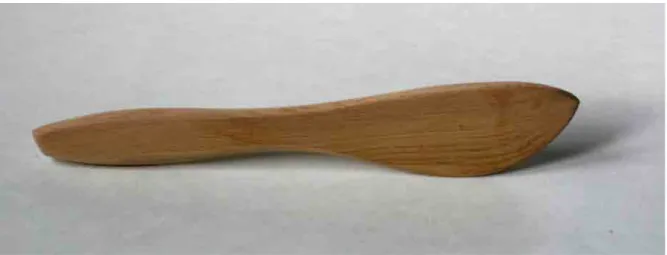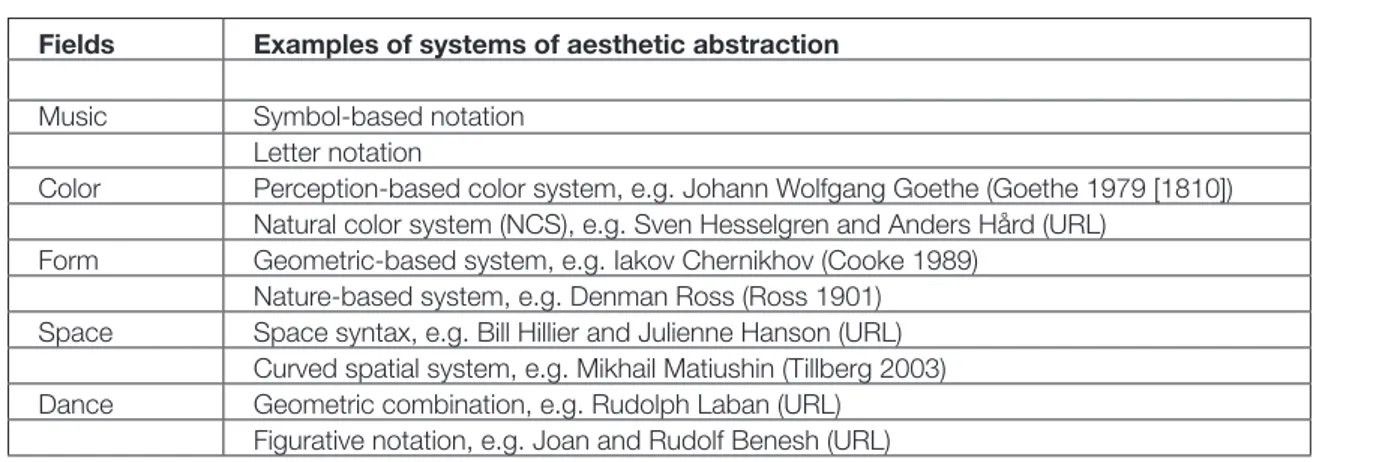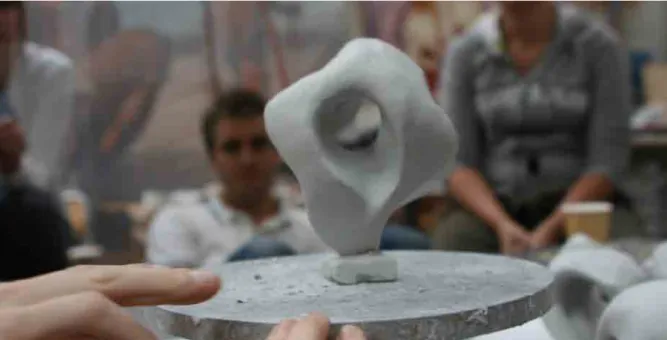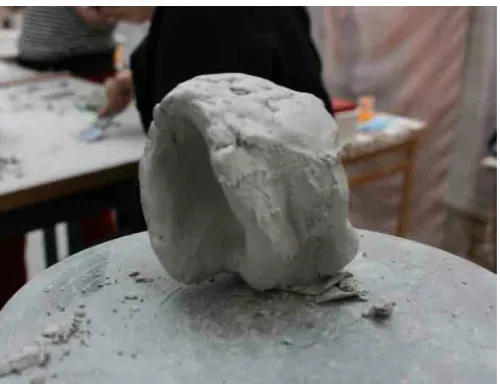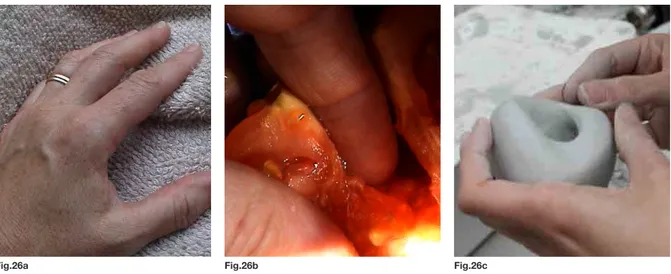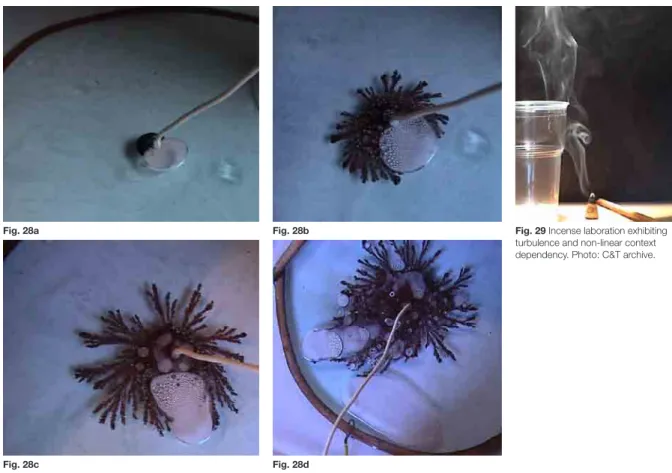THESIS FOR DEGREE OF DOCTOR OF PHILOSOPHY THESIS FOR DEGREE OF DOCTOR OF PHILOSOPHY
FORM &
FORMLESSNESS
QuESTIONING AESTHETIC AbSTRACTIONS THROuGH ART PROjECTS, CROSS-DISCIPLINARY STuDIES AND PRODuCT DESIGN EDuCATION
CHERYL AKNER-KOLER
Photo: Åke Sandström THESIS FOR DEGREE OF DOCTOR OF PHILOSOPHY
Form and Formlessness is an experimental research project that investigates how aesthetic abstractions are developed through three approaches:
• an educational approach concerned with devel- oping an aesthetic discipline, supporting a form-giving process aimed to create tangible artifacts. •
an art-based approach supporting an open explo-ration of distortion and formlessness.
• a cross-disciplinary exploratory approach con-cerned with aesthetic experiences shared in laborations demonstrating complexity and trans-formation.
The thesis offers methods and models that both sup-port and challenge the normative concepts of beauty, with high relevance for teaching 3-D formgiving aes-thetics and research by design methodologies.
Cheryl Akner-Koler is professor in form theory and practice at the Department of Industrial Design at Konstfack University of Arts, Crafts and Design in Stockholm, Sweden. She is an active sculptor and has driven many collaborative art/ science proj-ects on themes such as empty space, infinity and complexity. Form and Formlessness is her doctorial thesis. www.axlbooks.com info@axlbooks.com RESEARCH COLLAbORATION bETWEEN Department of Architecture Chalmers university of Technology Göteborg, Sweden 2007
Examination rights – Chalmers
Department of Industrial Design Konstfack university College of Arts, Crafts and Design
Stockholm, Sweden 2007
664462 789197 9
ISBN 978-91-976644-6-2
Photo: Åke Sandström
C h ER y L AKNER -KOLER
<axl>
FORM & FORMLESSNESS
Questioning Aesthetic Abstractions through Art Projects, Cross-disciplinary Studies and Product Design Education
CHERYL AKNER-KOLER
RESEARCH COLLABORATION BETWEEN: Department of Architecture
Chalmers University of Technology Göteborg, Sweden 2007 Examination rights – Chalmers Department of Industrial Design Konstfack University College of Arts, Crafts and Design
Questioning Aesthetic Abstractions through Art Projects, Cross-disciplinary Studies and Product Design Education
CHERYL AKNER-KOLER © Cheryl Akner-Koler 2007 Doktorsavhandling vid Chalmers tekniska högskola Ny serie nr 2659
ISBN 978-91-7291-978-5 ISSN 0346-718X ISSN 1650-6340, 2007:04
Publikation – Chalmers tekniska högskola Avdelningen för Arkitektur
RESEARCH COLLABORATION BETWEEN: Department of Architecture
Chalmers University of Technology Göteborg, Sweden 2007 Examination rights – Chalmers Department of Industrial Design Konstfack University College of Arts, Crafts and Design
Stockholm, Sweden 2007 www.konstfack.se
cheryl.akner.koler@konstfack.se Cover photo, front and back:
Sculpture: Twisted Curvature, Cheryl Akner-Koler Photo: Åke Sandström
Printed by Printfinder in Riga (Latvia) 2007 Axl Books
www.axlbooks.com info@axlbooks.com ISBN 978-91-976644-6-2
This research is based on empirical, embodied studies aimed to generate and regenerate aesthetic reasoning through three approaches:
• an educational approach concerned with developing an aesthetic discipline, supporting a formgiving process aimed to create tangible artifacts.
• an art-based approach supporting an open exploration of distortion and formlessness • a multi-disciplinary exploratory approach concerned with aesthetic experiences shared in laborations demonstrating complexity and transformation.
The overall aim of the thesis is to explore different types of aesthetic abstractions that elaborate aesthetic reasoning about form and formlessness. The thesis develops methods and models for aesthetic investigation that support, challenge and go beyond the norma-tive concepts of beauty, with high relevance for teaching 3-D formgiving aesthetics and research by design methodologies. A central method applied throughout the entire research project is a cooperative inquiry method engag-ing students and experienced professionals as co-researchers in embodied/ interactive physical form studies and laborations. The content of the thesis is presented in three parts relating to the approaches above: -Part 1 defines an aesthetic nomenclature organized within a taxonomy of form in space. This aesthetic taxonomy is outlined in five lev-els based on essential aesthetic abstractions, emphasizing structure and inner movement in relation to the intention for the development of a gestalt. It originates from the educational program of Alexander Kostellow and Rowena Reed and has been further developed through an iterative educational process using a Con-cept-translation-form method, resulting in the Evolution of Form (EoF)-model. This EoF-model reciprocally weaves together geometric
struc-tures and organic principles into a sequence of seven-stages. To question the normative principles of beauty inherent in the EoF-model, a bipolar +/- spectrum was introduced at each stage to expand the model, aiming for a more inclusive approach to aesthetics.
-Part 2 both challenges and expands the aesthetic reasoning in part 1 through i) solo sculptural exhibitions exploring properties of distortion and transparency in a constructivist art community ii) collaborative projects with physicists concerning infinity and studies of continuous complex curvatures and iii) explorative studies of material breakdown and non-visual studies with ID Masters students at Konstfack.
- Part 3 problematizes the taxonomy of form by applying methods and results from a cross-disciplinary study of complexity and transformation involving artists, physicists, designers and architects. The three year study explored temporal events of changing phe-nomena and formlessness that did not comply with any traditional aesthetic norms. Based on experience from 12 laborations, three models were developed: The Transforma-tion-model and Framing the dialogue-model were developed to physically interact with as well as to document and discuss change and transformation through bipolar reasoning. The Aesthetic phase transition-model was developed to capture the particular properties expressed in a transformation and unify stable objects with changing events.
In conclusion, the thesis claims the value of an inclusive aesthetic mode of abstract reasoning in the scientific and design com-munities. A provisional 3 modes of abstrac-tion-model is presented placing numeric, linguistic and aesthetic modes of abstraction as interdependent within a spectrum from separation to contextualization.
ABSTRACT
Key words: Aesthetics, architecture, formgiving, gestalt, complexity, embodiment, art, design education, taxonomy.
PART 1
Developing an aesthetic taxonomy of form Paper I
Akner-Koler, Cheryl. 2006.
Expanding the boundaries of form theory. Developing the model Evolution of Form. Paper presented at Proceedings: Wonder Ground Design Research Society International Conference, IADE, November 1-4, in Lisbon, Portugal. (http://www.iade.pt/drs2006/won derground/proceedings/fullpapers/DRS2006_ 0260.pdf)
Paper II
Akner-Koler, Cheryl. 1994.
Three dimensional visual analysis.
Printed by Swedish National Education Board, Stockholm, Sweden. Reprinted 2000. ISBN: 91-87178-16-5. Translated to Korean by Chun-shik Kim. Chohyong Education Ltd 2000.
PART 2
Expanding & challenging the Evolution of Form-model Paper III
Akner-Koler, Cheryl. 2006.
Twisting, blurring and dissolving the hard edges of constructivism.
Partaking in exhibition and catalogue essay in
Konstruktiv tendens 25, Ed. Françoise
Ribey-rolles-Marcus, 14-17. Stockholm: Konstruktiv tendens
Work/ Paper Iv
Akner-Koler, Cheryl, Bergström, Lars, Yam-dagni, Narendra and P.O. Hulth. 2002. “Infinity” (exhibition and program) shown Sep-tember 17-29 at Kulturhuset, in Stockholm, Sweden. (www.formandformlessness.com) Paper v
Akner-Koler, Cheryl and Lars Bergström. 2005. Complex curvatures in form theory and string theory. Leonardo, vol. 38, No. 3: 226-231. Paper vI
Akner-Koler, Cheryl. 2006.
Challenging and expanding the Evolution of Form-model. Paper presented at Proceedings: 5th Nordcode seminar & workshop Connecting
fields, May 10-12, in Oslo, Norway. (http://nordcode.tkk.fi/oslo.html)
PART 3
Formlessness - beyond the aesthetic taxonomy of form Paper vII
Akner-Koler, Cheryl. 2007 (revised version). Unfolding the aesthetics of complexity Cross-disciplinary study of complexity and transformation: Evaluation for the Swedish Research Council (vetenskapsrådet). Paper vIII
Akner-Koler, Cheryl. 2006.
Contextualizing aesthetic reasoning through a laboration on dendritic growth. Generating and regenerating aesthetic concepts through cross-disciplinary studies. Paper presented at Proceedings: Symmetry Festival, August 12-18, in Budapest, Hungary.
(http://www.conferences.hu/symmetry2006) Paper IX
Akner-Koler, Cheryl, Billger, Monica and Catharina Dyrssen. 2005.
Cross-disciplinary study in complexity and transformation: Transforming aesthetics. Paper presented at Proceedings Joining forces conference ERA, University of Art and Design, September 22-24, in Helsinki, Finland. (http://www.uiah.fi/page.asp?path=1866;1919; 4179;4698;11302)
Work/Paper X
Akner-Koler, Cheryl (project leader and pro-ducer), Norberg, Björn (co-producer) Kajfes, Arijana and Ebba Matz (exhibition concept.) 2005.
“Cross-disciplinary study of complexity & transformation” (exhibition & program.) Shown November at Höglagret, in Stockholm, Sweden.(http://www.complexityandtransfor-mation.com
LIST OF
PUBLICATIONS
This thesis is based on the work contained in the following papers
DISTRIBUTION OF WORK
(SPECIFICATION OF CONTRIBUTIONS BY EACH AUTHOR)
Work/ Paper Iv: Exhibition and program Planning and production of the exhibition: Akner-Koler, Lars Bergström, Narendra Yamdagni and P.O. Hulth.
Lectures given by: Bergström, Akner-Koler, Narendra Yamdagni, Anna Berglind, Hulth and Monica Sand.
Paper v
Akner-Koler planned the outline of the paper. Lars Bergström prepared the visual material, analysis and discussion for the Calabi-Yau. Akner-Koler prepared the visual material, analysis and discussion for the development of the compound curvature sculpture and point clouds. Akner-Koler and Lars Bergström both contributed to writing the paper. Paper IX
Akner-Koler planned the workshop and labo-ration. Monica Billger and Catharina Dyrssen were active participants in the laboration and gave theoretical and practical support for the development of the complexity and transfor-mation project. Akner-Koler planned the out-line of the paper. Akner-Koler and Catharina Dyrssen contributed to writing.
Work/ Paper X (exhibition and program) Project leader: Akner-Koler. Co-project leader: Narendra Yamdagni. Producers: Akner-Koler and Björn Norberg. Exhibition concept and film editing: Arijana Kajfes and Ebba Matz. Exhibition participants: Teo Enlund, Christian Bohm, Gustaf Mårtensson, Pablo Miranda, Elisabet Yanagisawa Avén.
Assistant: Carolina de la Fé.
Moderators: Teo Enlund, Björn Norberg, Arijana Kajfes, Catharina Dyrssen, Cheryl Akner-Koler.
Graphics: Mario Sierra
Additional publications by the author
Akner-Koler, Cheryl. Sculptural possibilities in design. In: Objects and images. vihma, Susann (ed). University of Industrial Arts, Helsinki, Finland, 1992, pp. 114-117 (from Semiotics conference)
Akner-Koler, Cheryl. Det visuella. En utmaning för designern.
Form 1987; no 5: pp. 22-25
Akner-Koler, Cheryl. Geometrisk Parallell. In: Barns bildskapande. Anna Heideken (ed). Centrum för barnkulturforskning, Stockholm University 1986 (in Swedish).
TO MY HUSBAND GUNNAR
FOR HIS INFINITE SUPPORT
CONTENTS
Acknowledgements xi
List of figures xiii
1. Introduction 1
1.1 Area of research investigation 1
1.2 Form and formgiving 2
1.3 Formlessness and art 3
1.4 Research profile 6
1.5 Aims 7
1.6 How to read the thesis 7
2. Theoretical framework 9
2.1 Aesthetics 9
2.2 Form 16
2.3 Formgiving 21
2.4 Formlessness 26
3. Results: Summary and discussion 35 Part 1: Developing an aesthetic taxonomy of form 35 Part 2: Expanding and challenging the
Evolution of Form-model 41
Part 3: Formlessness – beyond the taxonomy of form 46 4. Methods and procedures: Summary and discussion 53 Part 1: Developing an aesthetic taxonomy of form 54 Part 2: Expanding and challenging the
Evolution of Form-model 58
Part 3: Formlessness – beyond the taxonomy of form 60 5. Contributions, conclusions and future plans 65
5.1 Contributions 65
5.2 Concluding remarks 66
5.3 Future plans 67
6. References 69
7. Summary of papers 73
Paper I: Expanding the boundaries of form theory.
Developing the model Evolution of Form 79 Paper II: Three dimensional visual analysis 95 Paper III: Twisting, blurring and dissolving the
hard edges of constructivism 167 Work/Paper Iv: Infinity (exhibition and program) 171 Paper v: Complex curvatures in form theory and string theory 179 Paper vI: Challenging and expanding the
Evolution of Form model 187
Paper vII: Unfolding the aesthetics of complexity.
Cross-disciplinary study of complexity and transformation
(revised version 2007) 197
Paper vIII: Contextualizing aesthetic reasoning through a laboration on dendritic growth. Generating and regenerating aesthetic concepts through
cross-disciplinary studies 225
Paper IX: Cross-disciplinary study in complexity
and transformation: Transforming aesthetics 237 Work/Paper X: Cross-disciplinary study of complexity &
This research project has been a collaborative project from the beginning to the end. Without the generous help and support of my supervisors, students, colleagues, artists researchers, friends and family I would have never been able to develop the experience, research material and reasoning that I present here.
A joint research collaboration between the Dept. of Industrial Design at Konstfack and the Dept. of Architecture at Chalmers made it pos-sible to blend an academic research discipline with an art/design cul-ture. I am deeply thankful to my supervisors at Chalmers, Monica Bill-ger and Catharina Dyrssen, for making this collaboration as creative, demanding and smooth as possible. Their combined experience in art/architecture/design practice and research offered me the diversity and discipline I needed to explore applied aesthetic research. Monica, you have my warmest thanks for being my main supervisor as we transformed my teaching experience, art projects and cross-disciplinary studies into a research framework of methods, models and concepts. Your rigorous experimental research experience in color was vital for shaping the overall theme of my thesis. Thank you for all the hours of critical reading of my papers, improving the communicative value of my models and de-mystifying the research labyrinth that overwhelmed me at times. Also thanks for creating the inspirational laboration “Glade”, for taking wholehearted part in the Complexity and transformation (C&T) project and for allowing our friendship to grow during these five years of play and struggle. I would also like to express my deepest gratitude to Catharina Dyrssen for sharing with me your passion for applied research. Catharina, you had a special sense of timing as my supervisor, offering inspiring and precise theoretical/practical advice at many critical moments throughout part 3 of my research and the emerg-ing structure of the “coat” of the thesis. You underlined the value of doing explorative physical laborations in the C&T project and shared your insight from music and temporality, which profoundly affected my conceptual development concerning the relation between events and objects. Your overview in the field of theoretical and applied aesthetics was extremely important for helping define and focus my theoretical framework.
I wish to thank Lars Lallerstedt, who founded and headed the Dept. of Industrial Design (ID) at Konstfack, for giving me the opportunity to develop and teach the curriculum for basic form studies. Your commitment to the role the arts play in design education and your respect for aesthetic reasoning was of fundamental importance for developing the educational program at ID supporting form theory and practice. Thank you Lars for entrusting me with such a challenging project.
I am also grateful to Teo Enlund, who is currently chairing the Dept. of Industrial Design at Konstfack, for strongly supporting the transfor-mation of the infrastructure at Konstfack as we embrace a research culture and for re-establishing the formgiving process within our educational program. Thanks Teo for your playful inventiveness as you participated in the C&T project and for supporting my research collaboration with Chalmers. I look forward to the challenges facing us as we create ID’s new Masters program: Formgiving Intelligence. I which to express my gratitude to the students at the Dept. of Indus-trial Design at Konstfack. Without their enthusiasm, explorative
ACKNOWLEDGEMENTS
attitude and skillfulness I would never have found the drive to start and continue the educational profile of my research. Thanks to our former students who apply aesthetic reasoning in the practi-cal, Industrial Design profession, especially to No Picnic for their inspiring success. Thanks also to current and former students for the constructive discussions we have, questioning the limitations of a discipline rooted in essential aesthetic abstractions.
I am also thankful for the inspiring atmosphere created around me during all these years, which has kept my work integrated with the other subjects and issues within our department. Thanks to: Bosse Lindström for supporting the skillful craftsmanship of our students to create 3-D physical models. Rune Monö, Anna Thies and Teo Enlund for working with me to weave together semiotic communication with aesthetic reasoning. Leif Thies for inspiring the ecology studies of material breakdown from which the theme formlessness emerged and for supporting the creative formgiving process through drawing and presentation skills at our department. Agneta Althoff´s support has also been of utmost importance as we administrated the different educational and collaborative projects through our department. Thanks also to prefect Helena Söderberg for supporting Konstfack, our Dept. of ID and my thesis development as we gradually introduce a research culture.
I wish to express my gratitude to Ivar Björkman, the dean of Konst-fack, for daring to take on the project of bringing Konstfack out of its academic isolation and into the research world.
I wish to thank Arijana Kajfes, who has acted as an unofficial supervi-sor as we started up the C&T project and through many of the dif-ficult phases of the project. Arijana, your approach to artistic practice has been a great source of energy for me. Thank you for bringing coherency to this project when I really needed it and believing so adamantly in the open and explorative ways of the arts. Thanks also for conceptualizing the final C&T exhibition together with Ebba Matz and for your strong friendship through it all.
I am also most grateful to Narendra Yamdagni, who has offered a great counter balance, keeping our C&T project on course. The many hours we have shared together as we have planned workshops, evaluations, exhibitions and seminars have always been exciting for me. Our shared compassion and common interest in learning about phenomena in the physical world bridges all our differences. Thank you Narendra for everything!
I would like to thank Lars Bergström for all your encouragement and involvement in our Art/ Science projects, from: Empty Space to Complexity. Your commitment to education and your concern for finding ways to share experience and knowledge between disciplines has been vital for the development of Part 3 of my research. Thanks for exploring twisted and multiple dimensions with me and for draw-ing parallels between seemdraw-ingly unrelated phenomena like a burndraw-ing eggplant and astronomic events. You have always managed to con-nect our projects to essential questions in art and physics. Thanks also to Per Olof Hulth for taking part in all the initial meetings and first two projects. Your improvisation attitude to how projects de-velop over time really helped set the course of our explorative ways of driving cross- disciplinary projects.
Carolina de la Fé, thanks for your relentless support and assistance in helping to develop conceptual as well as very practical solutions to the problems we were faced with throughout the entire C&T project. Your spontaneous, thoughtful and humoristic ways kept our spirits high. I thank all the people in the entire C&T network that have been so generous with their time and creative/disciplined reasoning through-out this project. I especially thank:
- Björn Norberg for co-producing the C&T exhibition/program and for your critical awareness of the gap between art and science, as well as for your healthy disinterest in the concept “aesthetics”. - Gustaf Mårtensson for your embodied methods of gaining insight into the turbulent nature of anything around you. Thank you also for inspiring our ID students by bringing art/ design and research together .
- Ebba Matz for your spatial reasoning combined with your subtle care for simple details as you participated in the C&T laborations and conceptualized the final C&T exhibition together with Arijana Kajfes - Christian Bohm for your devotion to the arts and your passion in maintaining an objective view in chaotic situations.
- Fredrik Berefelt for your genuine concern for understanding the abstract spatial aspects of complexity mixed with your ambivalence about our ability to grasp it.
- Elisabet Yanagisawa-Avén for sharing your cross-cultural under-standing of the limits of western aesthetic thinking and your insights in the amorphous field.
- Pablo Miranda for sharing with us your research in the mechanisms of change. Your work has been very instrumental in showing how art and architecture also work with rule based processes.
- Stina Lindholm for taking part in the C&T laborations and for sup-porting my work in basic form education.
- Jonas Runeberg and Splintermind for creative experimentation with projection methods and developing SAPS
- Bengt Alm, who was both an active participant and photographer during the last half of the C&T project, thanks for the inside view through your camera.
Also I extend my thanks to photographers, Marcus Öhrn and Anna Löfgren for documenting the C&T exhibtion in photos and film. I would also like to thank my three previous opponents in the re-search seminars, Cecilia Häggström, Margareta Tillberg and Bengt Mollander, for valuable and constructive advice.
Furthermore I would like to thank gallerist Monica Urwitz and the art community around gallery Konstruktiv Tendens in Stockholm with artists Lars-Erik Falk, Gert Marcus and especially thanks to Francoise Riberollyes-Marcus for your friendship and support as I shifted my interest away from non-geometric abstraction.
I am indepted to Åke Sandström for photographing many of my solo shows and collective exhibitions and for sharing a deep common interest in how light-modulation articulates form. Thanks, Åke for all your support and friendship. Thanks also to Olof Glemme for photo-graphic documentation in the first few years of my search in material breakdown and formlessness.
Agneta Oledahl and the students at Formakademi in Lidköping: Thank you all for taking on the project to renovate and produce 3-D models that are used to illustrate the revised Evolution of Form-model and future revisions of paper II. And special thanks to Irina Johansson for your generous support as a teaching assistant and for finishing the last models.
I wish to again acknowledge Rowena Reed and Alexander Kostellow for putting together such a coherent and inspiring edu-cational program that interlaced perceptual research methods and aesthetic reasoning. Their pioneering work has always given me a strong foundation to work from. Without the experience I gained through working and studying with Rowena Reed, I would not have had the sense of direction I felt through all three parts of my research. I would like to thank the following schools for arranging workshops and conferences that have contributed to the development of this research:
• The Art Industry School at the University of Göteborg, Sweden • Umeå Design School at the University of Umeå, Sweden • Oslo School of Architecture, Norway
• Aalborg University, Denmark
• I especially thank Paul Östergaard and Pete Avondoglio when they headed the Dept. of Industrial Design at Aarhus School of Architecture, Denmark. Thanks for making me a part of your team.
During the last phase of bringing this thesis together I would like to sincerely thank graphic artist Marcus Gärde for your creative and structured approach to giving form to this thesis. It was not easy to keep track of the text, figures and photos and the many revisions. Thank you Marcus for your devotion. In addition I am grateful to Staffan Lundgren for supporting the production of the thesis through Axl Books as well as Jennifer Evans for all the hours of proof reading the coat and many of the papers. Thanks also to Louise Häggberg and Henriette Kolbanck for supporting a graphic profile.
My greatest debt is to my husband Gunnar Akner: your own research projects and enduring support through all these years has been a true source of inspiration for me. Thank you for acting as my editor, which entailed patiently reading and supporting the maturation of the text and the structure of my papers and reports in this thesis. My deepest love and thanks goes to you Gunnar for helping me grasp my own research structure as I gradually discerned the contours of the coat of my thesis.
Most important, I want to thank my children, Cora and Malcolm, for their tolerance and active help as I worked through this seemingly unending project. I now plan to devote more time to help you through your quests in life.
Finally, I would like to express my gratitude for economic support: • Dept. of Industrial Design at Konstfack
• Dept. of Architecture at Chalmers
• Artistic Development at Konstfack for supporting part 1. • National Department of Education for supporting part 1. • Swedish Research Council ( vetenskapsrådet) for supporting
the C&T project
Fig. 1 Three bachelor’s exam projects: Fig. 2 Open rotating construction by Akner-Koler
Fig. 3 Embodied spatial colors by Akner-Koler
Fig. 4 Exhibition Empty space by Akner Koler Fig. 5 Phase transition: floating foam to stable foam Fig. 6 Workshop with No Picnic
Fig. 7 Positioning the aesthetics approach Fig. 8 Model: Fusion of our senses
Fig. 9 Developing sculptural skills in clay through motor activities Fig. 10 Swedish wooden butter knife
Fig. 11 Five examples of different systems of aesthetic abstraction Fig. 12 Geons
Fig. 13 Distorted rectangular volume (student work) Fig. 14 Wertheimer’s perceptual studies
Fig. 15 Haptic experiences of form
Fig. 16 From art to aesthetic to communication Fig. 17 Rune Monö’s holistic model 1997 Fig. 18 Cluster of synonyms for “formlessness” Fig. 19 Convexity and concavity
Fig. 20 Transparency
Fig. 21 Cloud chamber - embodiment of color by Akner-Koler Fig. 22 Glade laboration
Fig. 23 Rectilinear distortion Fig. 24 Dendritic crystal laboration Fig. 25 Blob
Fig. 26 Examples of three modes of touch according to David Katz Fig. 27a Homunculus brain
Fig. 27b Homunculus body Fig. 28 Dendritic crystal laboration Fig. 29 Smoke from incense laboration
Fig. 30 Aesthetic taxonomy of form in space (five levels) Fig. 31 Model: Evolution of Form
Fig. 32a Point-cloud volume by Akner-Koler Fig. 32b Dehydrated pear cube
Fig. 33 Expanding the model Evolution of Form Fig. 34 Embedding form in formlessness Fig. 35 Model: Transformation Fig. 36 Model: Framing the Dialogue Fig. 37 Model: Aesthetic Phase Transition Fig. 38 Spatial staging/exhibition Fig. 39 Students working at Konstfack Fig. 40 Turntable - gestalt
Fig. 41 Actual formgiving process - gestalt Fig. 42 Exhibition Infinity by Akner-Koler Fig. 43 Twisted curvatures by Akner-Koler
Fig. 44 Model: Transparent Calabi-Yau by Lars Bergström Fig. 45 Point-cloud volume - open concavity by Akner-Koler Fig. 46 Glade - introductory lecture
Fig. 47 Three examples of play Fig. 48 Haptic experiences
As the field of design becomes broader by involving knowl-edge gained from many other disciplines, the common ground that traditionally supported the profession is trans-forming. the historical identity of design as a profession that produces “tangible, physical artifacts” is no longer a central issue (Buchanan 2001). Instead, design can be defined as a pluralistic activity that affects the way we live in the everyday world, by creating services, knowledge, events, and artifacts. two common activities that the broad design culture tends to agree on are planning and organizing things into holistic solutions and inquiring into the real nature of things (nelson and Stolterman 2003, 39–46, 117–130). designers, and particularly industrial designers, are experienced in dealing with the interac-tion between people, events, and things in a real-world context. the field of design has therefore developed ways of reasoning that can work with contextualized problems that carry a high level of complexity. In my research, I position the arts and aesthetic reasoning as crucial fac-tors in the development of the design profession and its ability to deal with contextual and complex problems. It is therefore necessary to develop the field so that we continue to explore the unpredictable and spiraling nature (Jonas 2003) of the design process. I argue that we need the arts to keep the field of design open, because the arts question the normative boundaries within which the design profession tends to work. to achieve this, the embodied reactions and self-governing ways of the arts must be woven into the design fabric along with our practical skills, methods of investigation and abstraction, together with the development of design theory.
1.1 Area of research investigation
the area of investigation in the present thesis covers the role that aesthetic reactions and abstractions play in holistic thinking about creating artifacts in a changing process.
I begin by studying the organizing capacity of form on the concrete and abstract levels, tailored within a formgiving culture. the design process uses form to test and explore questions, values and potential solutions. I will investigate the pluralistic nature of form in space and its usefulness in the development of our cognitive and emotional abilities for problem solving. the emphasis should be on our need to become engaged and active in physical and emotional events in the real complex world, which takes us far beyond the law-bound principles of geometry and traditional design aesthetics.
Approach
I developed this research project from two different ap-proaches:
• from an educator’s approach in teaching form
analysis, aimed to prepare industrial designers
for the formgiving process of creating physical
products/artifacts.
• from an artist’s approach, working with the
theme formlessness in solo, collaborative and
cross-disciplinary studies in complexity and transfor-mation with physicists and other artists, designers and architects as well as explorative studies with current and former students.
Point of departure
My point of departure starts with my experience as a personal teacher’s assistant for and student of rowena reed-Kostellow for two years in the late 1970s. during these years I became immersed in the coherent and struc-tured approach toward understanding visual abstractions of form and space that she and her husband, Alexander Kostellow, developed at the Pratt Institute in new York city, uSA. (to avoid confusion, in the present thesis, rowena reed-Kostellow will be referred to as “reed” and Alexander Kostellow as “Kostellow”). through their close collabora-tive working relationship, reed and Kostellow created a
1. IntroductIon
comprehensive educational program for foundation-year courses in the structure of visual relationships, as well as courses for industrial designers (Greet 2002). these courses successively introduced different levels of visual complexity through concrete experiences in a variety of different two-dimensional (2d) and three-dimensional (3d) media. their program offered a system of terms, concepts, principles, and procedures that supported perceptual and conceptual involvement of the active designer and artist under the different phases of their education (Greet 2002) (see also chapter 2, “theoretical background and framework”).
1.2 Form and formgiving
My main interest is in supporting the skillful aes-thetic involvement of designers during the formgiving stages within the industrial design process. I have adopted, anglicized and updated the term formgiv-ing from the Swedish word formgivnformgiv-ing, meanformgiv-ing the conceptual and perceptual process of developing the product gestalt into a physical form, as an integrated aesthetic process within the industrial design process. the industrial design program at Konstfack was founded in 1980 as the first formal industrial design (Id) education in Sweden. Konstfack’s department of Id developed from an arts and crafts tradition that supported formgiving.
My research efforts have spanned over a period of twenty years, with several phases of development. I began with a three-year grant in 1990–1993 from the Swedish department of Education (in Swedish:
Univer-sitets- och Högskoleämbetet, UHÄ) that supported the
development of industrial design education. the grant was formulated by professor Lars Lallerstedt, who founded the department of Industrial design at Konst-fack. Prior to this grant, I had been responsible for the development of our foundation program in 3-d form
from the middle of the 80s, that prepared our students for the coming formgiving challenges they would meet during traditional product development. As the program developed, I produced teaching material that outlined the principles and methods applied in each course. this material was published in 1994 as a textbook under the title Three-dimensional visual analysis (Akner-Koler 1994, see Paper II).
Initially I introduced the geometric-organic (geo-or-ganic) foundation of reed and Kostellow. (Greet 2002). this was based on law-bound geometric volumes that merged with organic principles in a comprehensive ap-proach. one would assume that aesthetic methods and concepts concerned with developing a foundation for 3-d formgiving were fairly well defined, since industrial designers, traditionally, have seen their main role as shaping products (Buchanan 1995). However, this is not the case. there is, in fact, very little documentation about the active formgiving process. Some reasons for this are that:
1. documenting 3-d work is inherently problematic 2. the field of design has only recently been offered
the opportunity to do research
3. the resources in design research concerned with aesthetics tend to go towards consumer-based aesthetic preferences rather than opening up the formgiving process from a designers position. this lack of documentation and theoretical development about forming the artifact raises many questions about the identity of the design discipline itself.
In time, I developed a method that involved the stu-dents in expanding reed´s/ Kostellow’s foundation stud-ies of form and space compositions. Many of the form studies in our teaching program at Konstfack referred to similar concepts that could be presented through more comprehensive visualization models, which worked for various form and space studies. these collective efforts
led to the development of a taxonomy of form. thanks to the educational grant and funding from Artistic de-velopment (in Swedish: Konstnärlig utveckling, Ku) at Konstfack, I was able to reformulate and reorganize my teaching material into a comprehensive textbook, which is part of this thesis. I was then given more time and resources to integrate the foundation program with product-oriented courses at the department of Industrial design at Konstfack. these courses merged form and gestalt development with semiotics, where I collaborated for more than ten years with rune Monö (1997) and Bosse Lindström in model making in the second-year program. Later I invited Anna thies (in semiotics, when rune Monö retired) and teo Enlund (in color and gestalt) to join the teaching team. I have also supported and at times co-supervised the examination projects in the final year of the bachelor’s program (see figure 1).
As the field of design joins the research community, we enter with a very fuzzy identity. the traditional and methodological knowledge about the development of artifacts, embedded in the practice of design, is unartic-ulated. the multidisciplinary and spiraling design culture of today does not seem to create supportive conditions for the profession to do practice-based research about making physical artifacts. to deal with this spiraling na-ture of design, I place form in the context of formgiving at the hub, giving it a significant role in the first part of my thesis. this emphasizes the roots of industrial design as a profession that makes things in the real world (dunin-Woyseth and Bruskel and Amundsen 1995).
Fig. 1a
design and photo: robin Grieves. Fig. 1bdesign and photo: Jonas Ståhl.
Fig. 1 a-b Bachelor exam projects a. Inhalator, b. Alpine snowmobile.
The form is simply that part of the ensemble over which we have control. It is only through the form that we can create order in the ensemble. (Alexander 1964, 27)
christopher Alexander explains the need to use form for its controlling capacity (Alexander 1964). He works with form with the intent to deliver solutions. the tight schedules and economic framework of industrial design often focus the design process on solving particular problems, with very little time to develop coherent knowledge to enrich the field of design. to establish the field, we need to step back and create and document knowledge about form, to understand the explorative capacity of form beyond the needs of industry and the market place, and to question normative forces. My approach to developing exploratory knowledge has been through my role as an artist. I have spent half of my time in education and half on my own solo art or art-based collaborative project. the arts offer a free zone for unconditional exploration, which is explained in the coming section on formlessness.
1.3 Formlessness and art
constructivism and productivism
A constructivist artist community centered around the gallery Konstruktiv tendens in Stockholm became an important context for my own artistic development. the artists, gallerist, and collectors at the gallery taught me
Fig. 2 Open rotating construction.
Sculpture in plexiglass by Akner-Koler. Photo: Sune Sundahl.
Fig. 3 Embodied spatial colors. Sculpture in air-glass material by Akner-Koler. Photo: Åke Sandström.
about the russian constructivist and productivist move-ments and central European constructivism with its center at the Bauhaus. I also experienced an enormous variation of expression that pushed the limits of geometry and spatial dimensions. My own art work was supported through the gallery, where I staged several solo exhibitions and took part in many group shows (see Paper III).
I found that the constructivist movement united my work with form in an industrial design culture with my initial sculp-tural interest of exploring geometric distortion (figure 2). the russian constructivist and productivist art movement in the beginning of the twentieth century was one of the first art movements that directly collaborated with scientists (Lodder 1987 [1983]). It was also the major art movement that openly worked with industry to create products for society. the artistic roots of industrial design can be found in this movement, as can the methodological approach to aesthetic reasoning presented in this thesis.
Initially my own artistic interests were concerned with concepts of distortion. I limited my elements to hard-edged, planar structures that indirectly defined open construc-tions enclosing space pockets and creating voids as shown in figure 2. As a counterbalance to the dominant interest in form from the industrial design culture, I chose to emphasize spatial relationships in my art. Gradually I began to question the controlling role that concrete form elements take on and searched for media that prioritized spatial experiences. rowena reed had developed teaching methods with straight and curved planes aimed to expand, activate, and enclose space (Greet 2002). to push these
methods further, I began to work with translucency and degrees of material density aimed to dissolve the hard edge transitions between concrete form and void.
I joined the St. Erik “Art reservation”, headed by artist Kjartan Slettemark, who supported explorative processes. At that time my interest was in transforming material through combustion that created smoke, ashes (figure 3), and other unstable materials. this change in my art brought up temporal issues and put emphasis on changing events rather than on the stages and sequential reasoning I had developed in my form taxonomy (Paper II).
Slettemark and I produced an exhibition in the Future’s Museum in Borlänge called “transformation” (in Swedish:
Förvandling och Omvandling), I refer to my work in this
areas with temporal issues and the dissolving of materials into space as included in the search for formlessness.
collaboration between art/design and physics
My art projects in formlessness were open-ended and explorative. I studied Goethe’s perceptual work on trüben (a German word meaning “cloud”), which involved the embodiment of space and primary colors that arise in fog (Sällström 1979, 109–15). through my interest in Goethe, I collaborated with physicist Pehr Sällström, who had updated and translated Goethe’s color theory to Swedish. From my studies of smoke and fog, I became involved in a collaborative project on the theme Empty
Space with three physicists at Stockholm university:
Professor Lars Bergström, doctor narendra Yamdagni and Professor P.o. Hulth. this two-year project resulted
in an exhibition and seminar series on cloud chambers, smoke filled prisms, and air-glass, coal and vacuum in the old orangeri at Bergianska Gardens in Stockholm, supported by a grant from Stockholm culture capital 1998 (see figure 4). A short film was produced about this project and broadcast by Swedish television (see thesis website).
the empty space group was later invited to be part of an art and science festival at Kulturhuset in Stockholm 2002, where we presented an exhibition and program on the theme Infinity. In this project, I worked closely with Lars Bergström and explored complex curvatures in multidimensional space. Both these collaborative experi-ences focused on developing and producing exhibitions that involved the public in our projects. Again, emphasis was on showing the results of our work rather than pre-senting our methods about how and why we arrived at these results.
Parallel to my art projects, I also was able to engage industrial design master’s students to take part in explor-ing formlessness, beginnexplor-ing with a project on ecology (degerman 1997). We studied how organic materials could be transformed through dehydration and other processes such as heat, electricity, hydration and implo-sion (see figure 5). We also explored non-visual aesthetic studies of color and substance, which emphasized tactility, haptics, taste, temperature, and interactivity with emphasis on process (see film Non-visual color, on thesis website).
In collaboration with a design firm called no Picnic,
I put together a two-day exploratory workshop that exposed the designers (my former students) to the explorative aesthetics of “formlessness” and “material transformation” (see figure 6). the enthusiastic response the no Picnic group gave this workshop strengthened my convictions regarding the importance of explorative aesthetics.
needing to document and critically discuss what these exploratory aesthetic studies offered, I realized that the student courses and firm workshops could not provide a long-term forum for further development. Some of my former students sometimes found ways to apply these formless experiences in design; however, there was no feedback loop to help me develop knowledge from their products. I later used my experiences from the non-visual color laboration and the material transforma-tion laboratransforma-tion to develop a plan for collaboratransforma-tion with physicists, artists, architects, and designers, called a cross-disciplinary study in complexity and transforma-tion described below.
cross-disciplinary studies in complexity and transformation
through funding from the Swedish research council, I became project leader of a three-year project to conduct exploratory studies on the theme of complexity and transformation (c&t) (see Paper VII). this c&t project gave me the opportunity to explore the ideas I had been working on about formlessness and temporal changes in collaboration with other researchers, professionals, Fig. 4 Empty space exhibition at Bergianska gardens 1998 by Akner-Koler. Photo: Åke Sandström.
and teachers. My own drive to start such an explorative project was to counterbalance the structured geometric reasoning with form and materials in an industrial design context. I turned my back on the methods of abstrac-tion that relied on simple geometric, stable materials or a structured spatial 3-d matrix. the c&t project was demanding, since it did not refer to a common dis-cipline, only to a common yet ambiguous theme. the four workshops and 12 laborations introduced concrete examples of phenomena that demonstrated complexity and transformation. We managed to grasp the different interpretations of the theme through playful interaction with phenomena on an aesthetic level, where we could share our different views. the final report of this project is presented as Paper VII in the present thesis. through this project we created an archive of documentary video films from all four workshops, giving an inside view of the dialogue and concrete laborations we performed. there were also two exhibitions/seminars of our activities; one in the context of SAPS at Art.Platform (urL) and the second at Konstfack.
1.4 research profile
the design profession is going through fundamental changes that are creating an increasing gap between design and the arts/crafts. I see these human-centered activities of art and crafts being pushed aside rather than integrated with high technology and market strategies. My intention with the present thesis is to create a greater understanding for formgiving that embraces embodied methods of art and crafts within and beyond the indu-strial design field.
through the research culture at chalmers School of Architecture in Göteborg, in collaboration with Konstfack, I found support to conduct practice-based research that opens up aesthetic reasoning in both a mono-discipli-nary context of industrial design and in cross-disciplimono-discipli-nary projects. chalmers underlines the importance of develo-ping cross-links between experience, conceptualization, laboration, and problematization.
Fig. 6 a-c Workshop with no Picnic.
Photo: Akner-Koler.
Fig. 6a Fig. 6b
Fig. 6c Fig. 5 Phase transition: floating foam to stable foam. Photo: c&t archive.
1.5. Aims
this thesis aims:
1. to generate aesthetic strategies that support skill-ful formgiving methods of conceptualizing and shaping artifacts in a design culture
2. to create a taxonomy that reciprocally interlaces geometric law-bound reasoning with organic growth principles
3. to develop constructive and critical methods and models that challenge normative trends in design 4. to conduct exploratory, cross-disciplinary studies
in complexity and transformation that support the renewal of aesthetic reasoning in both the art/de-sign and scientific communities
5. to generate methods that lift aesthetics into a dy-namic mode of reasoning that supports change, transformation and formlessness
6. to support the interaction between the explorative, embodied approach of the arts and the didactic and concrete needs of design education
1.6 How to read the thesis
this thesis on art and design research mixes academic writing with presentation methods and exhibition/works from art and design traditions.
Structure of the research and disposition of thesis the written material in the present thesis applies three writing styles. Most of the written articles use an academic writing style called the IMrAd structure (Introduction, Methods, results, and discussion). this writing style entails separating the background information, the methods used to conduct the study, and the results of the study with an overall discussion at the end. I found that this structure of academic writing helped to open up my work so I could present and discuss it with other researchers. It also set boundaries for the questions I set out to answer so I could easily focus on the different areas within the research project. the remaining written papers use the academic structure of reports as well as an essay form.
Also included in the papers are “works,” such as physical exhibits of artifacts and media productions with accom-panying catalog texts, which will be presented on a thesis website. the combined presentation of both papers and works thus reflects ways for both the scientific community and the art and design community to share knowledge and experience. All ten “papers” in the present thesis refer to practice-based experiences centered around aesthetic issues concerning physical form and phenomena. the Papers have been organized in three parts:
Part 1: developing an aesthetic taxonomy of form Part 2: Expanding and challenging the
Evolution of Form-model
Part 3: Formlessness—beyond the aesthetic
taxonomy of form
the comprehensive summary (“coat”) of the present thesis is comprised of seven chapters ending with the individual ten papers:
chapter 1. Introduction: Explains the area of
investiga-tion, my point of departure, form and formgiving, formless-ness, and art, ending with the aims addressed in the thesis.
chapter 2. theoretical framework:
Presents the theoretical background of the field, limited to the scope of the research. this is done by positioning the research in the field of aesthetics and outlining the main theoretical and practical sources that are relevant for shaping the way I have approached the concepts of form and formlessness.
chapter 3. results – summary and discussion:
this chapter is organized around the same three parts as described above. Each part summarizes the results, then provides a general discussion, including strengths and weaknesses.
chapter 4. Methods and procedures—summary and discussion: this chapter is also organized around
the same three parts as described above. Each part summarizes the methods, strategies, and procedures, then presents a general discussion, including strengths and weaknesses.
chapter 5. contributions, conclusions and future plans: A summary of the particular methods and models
that the present thesis has developed and concluding thoughts about what these methods and models can offer in developing the field of applied aesthetics. this chapter ends with some suggestions for future plans.
chapter 6. references.
chapter 7. Summary of Papers. regarding referencing
due to the multi-disciplinary nature of the field of aesthet-ics and the large amount of internal cross-referencing in the literature from many disciplines and different epochs, I have found it hard to keep track of how I refer to my sources. to make this clear to the reader (and to myself), I have used a system of referencing that looks like this: (Jones 2002, 23 [1927]). the authors last name, a first date that indicates the quoted source and the page number if necessary, then in square brackets the date of the original
source.It is my hope that this system will help clarify to
the reader: a) that many of the ideas I present come from a different epochs; and b) that the information has been republished, because the sources are still of interest for an audience.
this chapter gives the theoretical background to my work and terminological definitions, presented in four main sections: • Aesthetics • Form • Formgiving • Formlessness 2.1 Aesthetics
this section presents theoretical support for defining aes-thetics within an applied, embodied context that recognizes the importance of immediacy through basic-level experi-ence. It presents the need to develop skills and methods that support a way of reasoning through tangible form, developing aesthetic abstractions, experiencing playful-ness, relying on sketching procedures, etc.
definition
the concept of aesthetics can be traced back to two main movements (dahlin 2002, 15): 1) Analytical aesthetics, which aims to separate theory from practice as well as to institutionalize aesthetics as belonging only to the fine arts, 2) Pragmatist aesthetics, which regards aesthetics as perceptual experience involved in the everyday world and aims to unify theory and practice. there is, of course, a gray zone between these two schools of thought; however, this research is primarily based on a pragmatist aesthetic approach (Shusterman 2000 [1992]) (see figure 7)
I refer to John dewey’s work, which outlines the main conditions of what is now considered pragmatist
aesthet-ics. He considers aesthetic experience as such that is
immediately felt and has a unifying holistic quality (dewey
1980, 38–44 [1934]). dewey is interested in aesthetics from the individual’s everyday experience. He also recognizes the organizational energy that an artist or designer works with during the active process of creating artifacts and events (dewey 1980, chap. 9 [1934]). dewey’s view of aesthetics involves a process of events that brings together intellectual and practical experiences through emotions. He states that our emotional, aesthetic reactions are what keep us involved in the immediate situation and embrace the feeling of the gestalt (dewey 1980, 42 [1934]). I need to make a distinction between analytical and pragmatist aesthetics because the intention of this thesis is to begin to establish a viable academic platform that can support practice-based aesthetic reasoning. A pragmatist aesthetic approach offers such a platform.
Science of sensuous cognition
the German philosopher Alexander Baumgarten’s 1735 definition of aesthetics as the science of sensuous
cogni-tion (Shusterman 2000, 263–7 [1992]) is frequently referred
to in the field of pragmatist aesthetics. He defined the word sensuous as meaning the “fusion of our senses,” and the word cognition as to “know.” the concept of
fusion emphasizes the real-world experience and
em-bodiment of knowledge, which is one of the themes of this research.
2. tHeoretIcAl FrAMework
Individual, social & cultural context
Everyday experience
Pragmatist aesthetics
Unify theory and practice
Analytical aesthetics Separate theory from practice
Fine art
Institutions, galleries, museums
Fig. 8 Model: Fusion of our senses—a visualization model developed to unite our senses into a coherent experience in the real world.
Experiencing an event
in
context
Fusion
of our
Senses
1
2 3
4
5
BIPOLAR CONCEPT CONCEPT Features Features + TIME Move Grasp touch taste Smell Hear See Balance=
According to richard Shusterman, Baumgarten recognized the importance of aesthetic reasoning to “promote greater knowledge” (Shusterman 2000, 264 [1992]) during scientific studies. Baumgarten understood the value of developing sensory skills that improved an individual’s ability to discern relationships between features, and to develop improvisation and imaginative capacity. Baumgarten suggested that aesthetic reasoning could offer ways to go beyond the established norms of order that scientists often rely on. He also proposed that aes-thetic experience prepares individuals to deal with relative values as a useful way of reasoning when one deals with new territories that challenge conventions (Shusterman 2000, 263–7 [1992]).
the presented Fusion of our senses-model in figure 8 (see Paper VIII) further illustrates two concepts regarding fusion: i) the spiraling form emphasizes Baumgarten’s idea of fusing the senses within an embodied real-world context; ii) the scale at the bottom of the figure refers to the sense of equilibrium that continually aims for a dynamic balance of aesthetic values.
the Fusion of our senses-model starts with the con-cept move at the top, then rotates clockwise through
grasp, touch, etc. to underline embodied reasoning,
emphasizing Kinaesthetic/haptic activities and placing
see last. It is through movement and interaction we can
fuse our senses together (dewey 1980, 118–25 [1934]). dewey claims that “vision is a spectator,” offering only a passive view of our world. this spectator view has dominated philosophy, aesthetics, and education for centuries (Levin 1999). today, there is greater awareness of how our conceptual language has been controlled by visual metaphors that reflect a shallow experience (Smith
1999). In line with this reasoning, I have come to question the way vision has previously dominated my theoretical aesthetic approach.
embodiment
The mind is inherently embodied, reason is shaped by the body, and since most thought is unconscious, the mind cannot know simply by self-reflection. Empirical study is necessary.
(Lakoff and Johnson 1999, 5)
Embodiment is a growing field of study that recognizes the role the body and perception play in developing the way we conceptualize the world. Strong evidence from scientific research is challenging the idea that the mind is separated from the body (norman 2002 [1988]). Instead, scientists such as neurologist Antonio damasio (2005 [1994]) state that our ways of reasoning arise from the commonalities between our mind and body immersed in the environment we live in. through perception and motor activity, we build up a pool of experience that forms our
cognitive unconscious (see figure 9). this pool of
uncon-sciousness greatly affects how we act and think. As we shift our understanding of how reason is shaped through embodied experiences, society is changing the way it looks at the fields of art, design, and crafts. these fields have a long history of gaining knowledge through embodied processes and therefore have a wealth of experience to share with the academic world.
Aesthetic reaction
that John dewey (1980, 119 [1934]) argued for and that has been important to the development of this thesis. What dewey aimed to support was the full force of an experience at the very moment one becomes aesthetically involved. He sees this immediacy as a key experience that builds on emotional involvement and recognizes the holistic features of the gestalt.
It cannot be asserted too strongly that what is not immediate is not aesthetic.
(dewey 1980, 119 [1934])
I build on dewey’s idea of immediacy and use the concept of aesthetic reaction, because I am interested in support-ing the action that may arise from the immediate aesthetic experience. In design, we work with a myriad of possibilities as we bring materials and techniques together to create a solution. Most developmental processes face many conflict-ing concepts or interests to be dealt with. What we need, to keep the process moving forward, is to dare to organized shape despite the turbulence in the process. Embodied aesthetic reactions can inspire the creation of such shape. rowena reed studied with Hans Hoffmann in Germany and applied his action painting methods in her teaching of 3-d visual structures. She saw a strong connection between reaction and reasoning through abstractions and creating spontaneous compositions (personal communication). Instead of starting with a white canvas as Hoffmann did, reed started with movements in physical space and the direct use of sketch materials. John rajchman (2003) sup-ports an aesthetic reaction that, however question action painting, yet still regards the sensation prior to reflective judgment as vital for new ideas to come.
In defense of the immediate sensuous character of aes-thetic experience, art theorist Susanne Langer explained what she called the “direct import” of expressions through form that have no prior activity of interpretation (Langer 1953, 31). Langer points out the difference between language and aesthetics by arguing that the elements of language (words) refer to conventions, while the ele-ments of aesthetics (form) use sensuous qualities that allow the form expression to immediately become a part of our ongoing experience at the moment. Her criticism, from the 1950s, of research in aesthetics is that there is a strong tendency to transfer the structure of language to the field of aesthetics without any deeper understanding of the nature of art and design.
I believe Langer’s main contribution to the field of aes-thetics lies in defining aesaes-thetics as a discipline in itself and not as another type of language (Langer 1953, 31). this insight should expand research in applied aesthetics to counterbalance the limitations of semiotics and semantics (both rooted in linguistics), which aim to categorize form through social conventions (see below in this chaper, Aesthetic abstractions: essential and substantial).
Basic-level experience
dewey stated that in order to understand the nature of aesthetic experience, “one must begin with it in the raw” (dewey 1980, 4 [1934]). He was referring to phenomena such as the sparks from a glowing fire, a bulldozer dig-ging pits in the earth, or the spiraling cutting edge of a corkscrew. dewey’s idea of raw aesthetic experience has strong parallels to what Lakoff and Johnson refer to as the basic-level experience, supported by findings in fields such as neurobiology and cognitive/perceptual science. Fig. 9a-c developing sculptural skills in clay through motor activities. Photo: Akner-Koler.
Fig. 9b Fig. 9c
